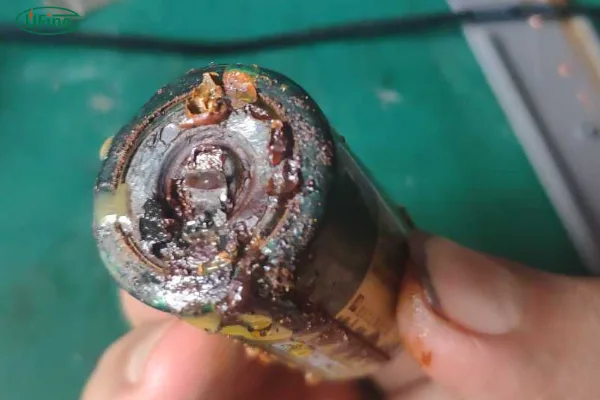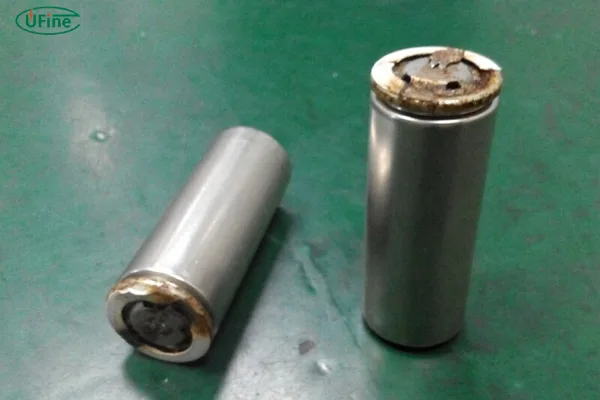Part 1. What is a li-ion battery leak?
Battery leakage occurs when the battery casing is damaged and the electrolyte leaks. This condition can have several causes, such as physical damage to the battery or a manufacturing defect.
Electrolyte is a mixture of corrosive and flammable chemicals that can be dangerous if it comes into contact with skin or flammable materials.
Lithium battery leak causes lithium batteries to suffer from electrolyte volatilization, moisture penetration, bulging, and many other problems, which lead to reduced performance of lithium batteries and even fire and explosion.
The impact of a battery leak can be devastating, both in terms of financial losses and potential harm to people.
Part 2. Why do batteries leak?
- Quality: Quality problems of the battery itself may cause battery leakage, such as defects in the battery casing or electrolyte leakage.
- Improper use of batteries: Overcharging or over-discharging will damage the battery, which may cause damage to the diaphragm inside the battery, resulting in liquid leakage.
- Battery aging: As the battery is used for a longer time, its internal chemicals will gradually age, causing battery performance to decline and liquid leakage to occur.
- Battery damage: When the battery is hit or squeezed by external force, it may cause damage to the internal structure and cause liquid leakage.
- Battery dampness: If the battery is exposed to a humid environment for a long time, it may cause an internal short circuit, which in turn causes liquid leakage.
- Improper maintenance: If the battery has been disassembled, modified, etc., but the operation is improper, it may also cause damage to the internal structure of the battery, causing liquid leakage.
- Charger: When charging with a low-quality charger, the voltage and current are too high, causing the battery to heat up and leak.
Part 3. What are the hazards of lithium battery leakage?

Lithium battery leakage can pose several hazards, including chemical, environmental, and physical risks. Here are the main hazards associated with lithium battery leakage:
1. Chemical Hazards
- Toxicity: Lithium batteries contain electrolytes and other chemical components, such as lithium salts, organic solvents, and heavy metals (in some types), which can be harmful to health if they leak. Direct contact with these chemicals can cause skin irritation, chemical burns, or more severe health issues.
- Corrosive Substances: The electrolyte in lithium batteries is typically corrosive. If it leaks, it can damage surfaces, corrode metals, or cause physical harm if it comes in contact with skin or eyes.
- Fumes and Vapors: Leaking lithium batteries can release harmful gases and vapors, such as hydrofluoric acid (HF) and other volatile organic compounds (VOCs), which can be toxic when inhaled. Prolonged exposure to these fumes may cause respiratory irritation or even lung damage.
2. Fire and Explosion Risks
- Highly Flammable: Lithium batteries contain highly reactive materials like lithium and organic solvents. If a battery leaks and the lithium comes into contact with moisture or other reactive substances, it can catch fire or cause an explosion. This is especially dangerous if the battery is damaged, punctured, or improperly stored.
- Thermal Runaway: When a lithium battery leaks, it could lead to thermal runaway, where heat causes the battery to self-ignite or explode. This is particularly dangerous if the battery is exposed to high temperatures, damaged, or short-circuited.
3. Environmental Hazards
- Soil and Water Contamination: The chemicals in lithium batteries, such as lithium salts and other toxic substances, can leach into the soil and water if not disposed of properly. This contamination can harm wildlife and ecosystems and potentially affect human water supplies.
- Hazardous Waste: Leaked or damaged lithium batteries should be treated as hazardous waste and disposed of according to proper regulations to prevent environmental damage.
4. Health Hazards
- Skin and Eye Irritation: If the leaked battery electrolyte comes into direct contact with skin or eyes, it can cause burns, irritation, and serious damage, especially if it contains hydrofluoric acid or other corrosive materials.
- Respiratory Issues: Inhalation of fumes from leaking batteries can irritate the lungs and respiratory system. In extreme cases, exposure to toxic gases may lead to more severe health issues like respiratory distress or lung damage.
5. Electrical Hazards
- Short Circuits: If battery leakage causes a short circuit in a device, it could lead to device failure, fire hazards, or even electric shock. Damaged devices may stop functioning or become dangerous if continued to be used.
Part 4. What should I do if the lithium battery leaks?
Here are some common disposal measures when a large lithium battery leak occurs.
1. Safety first
Keeping yourself safe is the most important thing. If the leaked liquid comes into contact with the skin or eyes, flush immediately with plenty of water and seek medical attention.
2. Isolation and ventilation
Quickly isolate leaking lithium batteries to a safe area. Keep away from flammable materials and other dangerous materials. Make sure there is good ventilation to prevent the build-up of harmful gases.
3. Prevent spread
Use appropriate protective equipment, such as gloves and safety glasses, to prevent the spill from spreading further.
4. Clean up spills
Small lithium battery leaks can be cleaned up using appropriate absorbents such as anhydrite or special absorbents. Be careful to use proper tools and avoid direct contact with spilled material.
5. Waste disposal
Place cleaned spills and absorbents into closed containers for proper waste disposal. Follow local rules and regulations and dispose of waste at a professional disposal facility.
Part 5. How to prevent battery leakage?
1. Choose Quality Batteries
- Reputable Brands: Use batteries from reputable manufacturers known for their quality control and safety standards.
- Check Expiry Dates: Avoid using batteries that are past their expiration date, as older batteries are more prone to leakage.
2. Proper Storage
- Cool, Dry Environment: Store batteries in a cool, dry place away from direct sunlight and extreme temperatures. High heat can cause batteries to swell, rupture, or leak.
- Avoid Humidity: Keep batteries away from moisture and humidity, as water can react with the chemicals inside the battery and lead to leakage.
- Organized Storage: Store batteries in their original packaging or in a battery storage case to prevent contact with conductive materials.
3. Avoid Overcharging and Deep Discharge
- Use Compatible Chargers: Always use chargers that are compatible with the specific battery type to prevent overcharging, which can lead to leakage.
- Monitor Charging: If using rechargeable batteries, monitor the charging process and avoid leaving them plugged in longer than necessary.
- Avoid Deep Discharge: For rechargeable batteries, try not to let them discharge completely, as this can lead to instability and potential leakage.
4. Handle Batteries Carefully
- Avoid Physical Damage: Do not puncture, crush, or drop batteries, as physical damage can compromise the battery casing and lead to leakage.
- Wash Hands After Handling: If you handle batteries, especially leaking ones, wash your hands afterward to avoid contact with any chemicals.
5. Regular Inspection
- Check for Signs of Damage: Regularly inspect batteries for signs of corrosion, swelling, or leakage, especially in devices that are used infrequently.
- Replace Old Batteries: Remove and replace batteries in devices that are not used often, especially if they have been in storage for an extended period.
6. Proper Disposal
- Follow Disposal Guidelines: Dispose of batteries according to local regulations and guidelines to prevent environmental contamination. Never throw them in regular trash.
- Use Recycling Programs: Take advantage of battery recycling programs to ensure batteries are disposed of safely and responsibly.
7. Use Battery Holders or Cases
- Separate Storage: Use insulated battery holders or cases to store batteries separately, preventing contact with conductive materials that can cause short circuits.
- Prevent Accidental Contact: Keep batteries away from metal objects (like coins and keys) that can create a short circuit.
8. Avoid Mixing Battery Types
- Use Same Type: Do not mix different types of batteries (e.g., alkaline with lithium or rechargeable with non-rechargeable) in the same device, as this can lead to leakage and malfunction.
9. Limit Exposure to Extreme Conditions
- Temperature Extremes: Avoid exposing batteries to extreme cold or heat, as this can compromise the battery integrity and lead to leakage.
- Humidity Control: If possible, use a dehumidifier in areas where batteries are stored to control humidity levels.
Part 6. How to detect lithium battery leakage?
There are many methods for detecting lithium battery leakage. The following are some standard methods:
1. Visual inspection
By observing the appearance and structure of the lithium battery, you can initially determine whether the battery has signs of leakage. For example, observe whether the lithium battery has cracks, leakage, etc., and whether there is an abnormal smell.
2. Helium detection
Helium gas is injected into a lithium battery, and a mass spectrometer is used to detect the presence of helium. If the mass spectrometer detects helium, it indicates a leak in the lithium battery.
3. VOC detection
Leakage in lithium batteries can be detected by using a photoionization sensor (PID) to see the concentration of volatile organic compounds (VOCs). VOC detection can detect tiny leaks and determine the location of the leak.
4. Electrolyte analysis
By analyzing the composition and concentration of the electrolyte, you can determine whether the lithium battery is leaking. For example, if water or impurities are present in the electrolyte, it could indicate a leak in the lithium battery.
5. Stress testing
Seal the lithium battery in a container and measure the change in pressure inside it. If a lithium battery leaks, the pressure will change. This method requires the use of professional testing equipment.
Temperature test: By monitoring the temperature changes of lithium batteries, you can determine whether the battery is leaking. For example, if a lithium battery’s temperature rises abnormally during charging, there may be a leak.
Ultrasonic testing: Use ultrasonic testing equipment to test lithium batteries. This method can detect tiny leaks and internal defects.
Related Tags:
More Articles

LiPo Battery Discharge Rate Guide & Calculation Tips
Understand LiPo battery discharge rates, C-ratings, and how to calculate max current. Essential guide for RC, drones, and electronics users.
High‑Capacity 3S LiPo Batteries: 5000 mAh vs. 10000 mAh
Compare 3S LiPo 5000mAh vs 10000mAh batteries by weight, power, and use. Find the best fit for your drone, RC car, or boat setup.
Top 5 Applications for Small 3S LiPo Batteries
Small 3S LiPo batteries power drones, RC gear, wearables, and robotics with high energy and low weight. Making them ideal for compact electronics projects.
Building and Charging Your Own 3S LiPo Pack: A Step‑by‑Step Guide
Learn how to build, balance, and charge a 3S LiPo battery pack safely at home with this complete DIY guide for hobbyists and beginners.
How to Choose the Right LiPo Battery Plug Type?
Discover the best LiPo battery plug types, how to choose them, and expert tips for safe usage, soldering, and maintenance.





